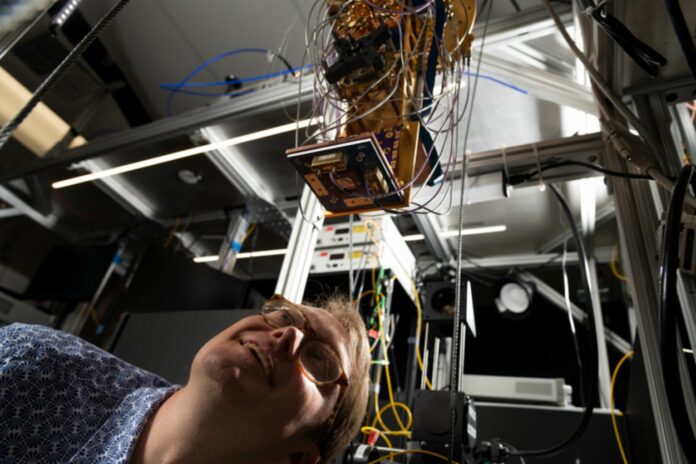A team of researchers led by Matthew D. Shaw at NASA’s Jet Propulsion Laboratory have developed a new detector, called PEACOQ (performance-enhanced array for counting optical quanta), that enables fast and precise measurement of the arrival times of single photons. This is crucial for quantum communication, which uses light at the single photon level to transmit encoded quantum information, such as encryption keys, in a manner that is guaranteed to be secure by the laws of physics. The PEACOQ detector is a significant step forward in achieving faster speeds in quantum communication.
This “new detector is made of 32 niobium nitride superconducting nanowires on a silicon chip, which enables high count rates with high precision,” according to Ioana Craiciu. “The detector was designed with quantum communication in mind, as this is a technological area that has been limited by the performance of available detectors.”
The detector was created as part of a NASA initiative to enable cutting-edge quantum communication technology that might one day allow the exchange of quantum information over intercontinental distances.
The PEACOQ detector is an advancement in technology developed for the NASA Deep Space Optical Communication project, which will be the first demonstration of free-space optical communication from interplanetary space.
“There is not currently another detector that can count single photons this quickly with the same timing resolution,” adds Craiciu. “We know this detector will be useful for quantum communication, but we also hope that it could enable other applications that we haven’t considered.”
To speed up quantum communication, the detector on the receiving end needs to be able to make measurements quickly and have a short “dead time” so it can deal with a high rate of photons. In addition to this, the detector has to make an accurate measurement of the time the photons arrive.
Although there are devices that can monitor photon arrival times with great accuracy, Craiciu said that they have trouble keeping up when photons arrive quickly one after the other and can miss photons or record their arrival times incorrectly.
“We designed the PEACOQ detector to precisely measure the arrival times of single photons even as they are hitting the detector at a high rate. It is also efficient – it doesn’t miss many of the photons.”
Nanowires about 7.5 nm thick, or around 10,000 times thinner than a human hair, make up the PEACOQ detector. The nanowires become superconducting when used at very low temperatures, such as 1 Kelvin, or -458 °F, which means they have no electrical resistance. Any photon that strikes a wire in a superconducting environment has a strong probability of being absorbed by that wire. Any photons that are absorbed produce a hot spot that noticeably raises the wire’s electrical resistance. A computer equipped with a time-to-digital converter records the instant when the resistance changed, indicating the arrival of a photon.
The time-to-digital converter detects the arrival time of this electrical pulse extremely accurately, with a precision below 100 picoseconds or 70 million times quicker than a snap of the fingers, according to Craiciu. When the detector measures a photon, it produces an electric pulse.
“We developed a new time-to-digital converter that can measure up to 128 channels at once with this timing resolution, which is important because our detector needs 32 channels.”
To demonstrate the novel detector, researchers placed it in a cryostat and chilled it to 1 Kelvin. They employed specially constructed testing equipment to transmit light to the detector within the cryostat, and a series of electronics to transmit, amplify, and record the detector’s output signal outside the cryostat. Due to the fact that there are 32 nanowires, the researchers needed 32 sets of each component, including 32 cables and 32 of each kind of amplifier.
“We were very pleased with how well the detector worked,” remarks Craiciu. “The rate at which it can measure photons was the highest we have seen. It requires a complex setup because each of the 32 nanowires is read out individually, but for applications where you really need to measure photons at a high rate with high precision, it is worth the trouble.”
In quantum communication, information is encoded into individual photons and transmitted according to a clock. The accuracy of measuring the arrival time of the photons at the receiver determines the speed at which information can be transmitted. The new detector allows for quantum communication at a high clock frequency of 10 GHz.
The PEACOQ detector is currently 80% efficient, meaning only 80% of the photons that hit the detector are measured. The researchers are working to improve this efficiency.
They also want to make a portable receiver that can be used for experiments with quantum communication. It will be equipped with a number of PEACOQ detectors, optics, readout electronics, and a cryostat.
Source: 10.1364/OPTICA.478960
Image Credit: Ryan Lannom, JPL-Caltech/NASA
